Comprehensive Guide to Kiteboard Handles and Their Impact

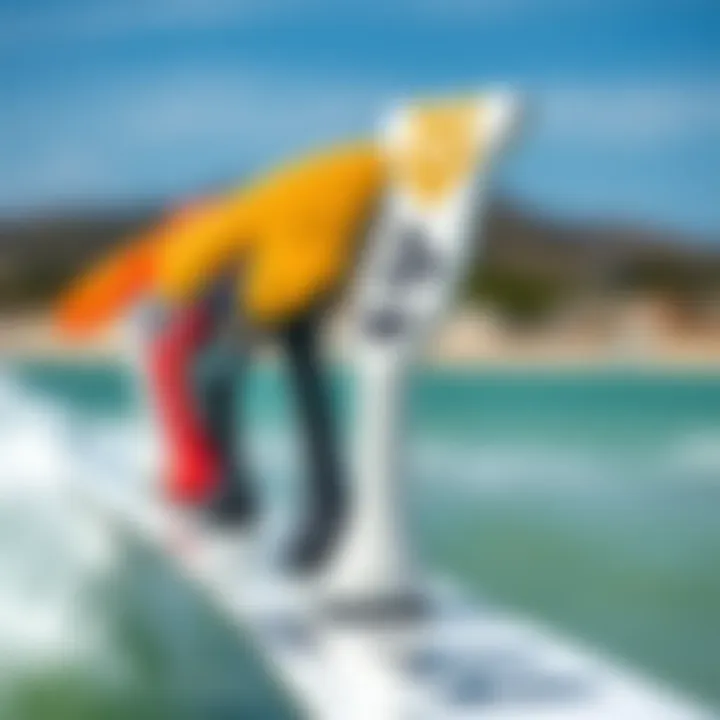
Intro
Kiteboarding is a sport that stirs the wind in your hair and the water beneath your feet. But there’s more under the surface than just the thrill of riding the waves. At the core of this dynamic sport lies the kiteboard handle—a piece of equipment that is often taken for granted yet serves a critical role in the overall performance and safety of a rider. In this guide, we will embark on an exploration of kiteboard handles, examining everything from their design and material choices to their significant impact on the rider's experience.
Every aspect of kiteboarding demands attention and precision, and handle selection is no exception. With a multitude of options available on the market, understanding what each handle has to offer can be the difference between a smooth ride and a harrowing experience. This article will delve into various types of handles, provide insight into how they are manufactured, discuss maintenance strategies, and weigh safety considerations—all tailored for both seasoned kiteboarders and newcomers to the sport.
Moreover, we’ll touch upon modern advancements in handle technology and what trends may shape the future of this vital piece of gear. Let’s unravel the complexities of kiteboard handles and discover how they can enhance your performance on the water.
Gear Selection
Selecting the right gear is foundational for any kiteboarding adventure, and this starts with choosing the appropriate handle. Here, we will look at types of kiteboard handles and factors to consider when making this choice.
Types of Handles
Kiteboard handles come in various shapes and sizes. Each type serves a different purpose, and knowing their distinctions is crucial:
- Basic Handles: These typically have minimal features and are suitable for beginners. Their simplicity allows new riders to focus on mastering their technique without any distractions.
- Grip Handles: Featuring a rubberized texture, these handles provide better grip, which is essential during tricks and jumps. The increased friction helps maintain control, particularly in challenging conditions.
- Lightweight Handles: Designed for performance riders, these handles prioritize weight reduction. They are often constructed from materials like carbon fiber, promising a stiffer feel that translates to improved responsiveness.
- Bar & Handle Combos: Some setups integrate both a handle and control bar into one unit, simplifying the rigging process and offering ease of use.
Choosing the Right Board
When selecting a kiteboard, it’s essential to consider the handle style in conjunction with board performance. An ill-suited handle can affect the ride significantly. Riders should evaluate several factors, including:
- Board Type: Freestyle, wave, or race boards have varying requirements and performance characteristics. Match your handle choice to the type of board you own.
- Rider Skill Level: As a novice, focus on straightforward designs that allow you to build confidence. Experienced riders might prefer more sophisticated options that enhance their tricks.
- Environmental Conditions: Wind strength and water conditions can also influence your choice. Reliable grip becomes even more crucial in rough waters or high winds.
In the next sections, we will detail skill development techniques and tips for progression that will further optimize your kiteboarding experiences.
Understanding Kiteboard Handles
Understanding kiteboard handles is fundamental for anyone serious about the sport. These critical components are not merely grips for the rider; they play a vital role in the overall kiteboarding experience. They are designed to enhance connection, provide stability, and allow riders to execute jumps, turns, and tricks with confidence. By comprehending how kiteboard handles function, one can make informed choices tailored to individual riding styles, preferences, and skill levels.
A kiteboard handle serves as the rider’s link to the kite and board. Choosing the right handle can make all the difference when navigating wind conditions or tackling tricky maneuvers. Beyond aesthetic appeal, the handle's design impacts grip comfort, control, and overall performance on the water.
Definition and Purpose
Kiteboard handles are specifically designed grips attached to a rider's kiteboard that facilitate maneuvering and provide stability during both powered and unpowered riding. Typically made from robust materials, these handles come with a series of features tailored to meet various riding needs. The essential purpose of these handles is to serve as a secure point of control, allowing the rider to channel their energy into the kite while maintaining balance on the board.
While the primary function is simple—to hold on—the design, material, and size of a handle greatly influence how a rider interacts with the kite and responds to the dynamics of the wind. An optimal handle enhances performance by enabling a more direct connection between rider and kite, making every maneuver feel more intuitive and controlled.
Importance in Kiteboarding Performance
The significance of kiteboard handles in performance cannot be overstated. A handle that is well-suited to a rider's style can vastly improve their ability to execute complex tricks and maintain control in challenging conditions. The wrong handle, however, might lead to discomfort or even hinder performance, creating unnecessary frustration during a session.
- Grip Quality: A good handle provides superior traction to ensure that the rider can maintain a firm hold even in rough waters. With the right grip, riders can transfer energy from the kite more effectively, resulting in smoother transitions and improved jumps.
- Stability and Control: Handles designed with ergonomic shapes can offer enhanced stability. When riders feel confident in their grip, they are more likely to push their limits and try new tricks, leading to improved skills and a sense of accomplishment.
- Injury Prevention: Inappropriately designed handles can increase the risk of wrist and hand injuries. A handle that fits comfortably not only enhances performance but also promotes safety.
- Adaptability: As riders progress, their needs from their handles may change. Understanding the range of handle options allows kiteboarders to adapt their equipment as their skills evolve.
"Choosing the right kiteboard handle is not only about performance; it’s about enhancing your riding experience and feeling connected to the water."
Types of Kiteboard Handles
When it comes to kiteboarding, handles serve as an essential link between the rider and their board. Selecting the right type of handle can elevate performance while ensuring comfort and stability. Thus, understanding the various types of kiteboard handles can help both novice and seasoned riders make more informed choices. Let's delve deeper into the distinct variants available on the market, highlighting their key features and advantages.
Basic Handles
Basic handles, often referred to as standard or fixed handles, are generally the first choice for many riders. They are designed with simplicity in mind, typically featuring a straightforward construction that emphasizes durability over extravagance. Made from materials like plastic or composite, these handles are lightweight and can endure rough conditions.
Quick and easy to use, basic handles are essential for a no-frills riding experience. Their design ensures that riders maintain firm grip while maneuvering through various conditions, whether it is choppy water or gusty winds. Riders can have confidence in their choices without worrying about excessive weight or complicated adjustments. Thus, for beginners entering the sport, basic handles provide a sturdy starting point without overwhelming them with the choices and features available in more advanced handles.
Adjustable Handles
Adjustable handles bring a level of customization that many find appealing. Riders of all skill levels can benefit from them. The primary feature here is the ability to modify the width of the grip, making it easier for various hand sizes and preferences. This feature is particularly beneficial for those who might share their equipment or for changing riding styles.
The flexibility in handle positioning can improve overall control and responsiveness during rides. When a rider tweaks the handle to better fit their personal preference, they can enjoy enhanced comfort, which can translate to more extended sessions on the water without discomfort. Whether it's a leisurely ride at sunset or pushing the limits with tricks, adjustable handles allow for easy transitions. Therefore, they are a favored option among those who appreciate the nuances of their equipment.
Specialized Handles for Tricks
For those looking to push the envelope with tricks and advanced maneuvers, specialized handles come into play. These are engineered specifically for performance, offering features that cater to the dynamic needs of riders performing high-intensity activities. For instance, many of these handles include specific grip patterns designed to reduce slippage during complex moves, ensuring that riders maintain control at all times.
Moreover, these handles often incorporate design elements like ergonomic shapes and padding, which enhance rider experience significantly. Riders engaging in trick-oriented kiteboarding can really appreciate how a specialized handle can make a significant difference—whether it provides the confidence needed to attempt a new trick or aids in achieving a higher level of control while landing.
In a sport where every detail matters, the right handle could be the difference between nailing that flip or ending up in a tumble.
"Choosing the correct handle isn't just a matter of preference; it's about fine-tuning performance and safety on the water."
In summary, the handle type can greatly affect not only comfort and usability for kiteboarders but also their performance in different kiteboarding scenarios. Understanding these distinctions helps individuals tailor their experience to their specific riding needs and aspirations.
Materials Used in Handle Construction
Understanding the materials utilized in kiteboard handles is crucial for both performance and durability in the sport. Each material brings its own set of advantages and disadvantages that can influence the overall kiteboarding experience. From the choice of lightweight plastics to robust metals, these variations not only affect how a handle feels in hand but also its longevity and resilience against the elements. Riders must consider factors like weight, strength, impact resistance, and weather resistance when selecting a handle material. An informed choice here can enhance control and overall safety, which directly correlates with performance on the water.
Plastic and Composite Materials
Plastic and composite materials are the backbone of many kiteboard handles, offering a blend of lightweight characteristics and resistance to corrosion. Generally, these materials are molded into shapes that provide an ergonomic grip, ensuring that the handle fits comfortably in the rider's hand without causing fatigue.
- Lightweight: Easy to handle and maneuver, allowing for better performance without weighing the rider down.
- Durability: High-quality plastics can withstand the harsh conditions encountered in kiteboarding, from saltwater to UV rays.
- Cost-effective: Typically, plastic handles are more affordable than their metal counterparts, making them a popular option for beginners.
However, there are downsides. Cheaper plastics may degrade over time, losing their structural integrity and grip. Therefore, riders should seek higher-grade composite plastics that combine materials for enhanced durability and performance. Brands have increasingly turned to hybrid materials, marrying the strengths of different plastics to craft handles that do not compromise on feel or safety.


Metal Components
Metal components in kiteboard handles add an element of strength that plastics alone can seldom provide. Often, aluminum and stainless steel are the materials of choice because of their balance between weight and robustness.
- Strength: Metal components are less likely to break under extreme stress, making them ideal for advanced maneuvers and challenging conditions.
- Aesthetic Appeal: Handles with metal elements usually offer a sleek, modern appearance that can enhance the overall look of a kiteboard setup.
- Corrosion Resistance: While metals can rust, using stainless steel or specially coated aluminum can mitigate this issue, ensuring the components maintain their integrity over time.
On the flip side, metal handles can be heavier, which may not suit everyone’s style. Moreover, the increased cost may deter novice riders who are just starting with kiteboarding. An intelligent rider considers their skill level and chooses materials that match their abilities and aesthetics.
Impact of Material Choice on Performance
The materials used in kiteboard handles have profound implications on performance metrics, such as control and responsiveness. For example, a lightweight handle made from high-quality plastic may allow a rider to perform tricks with agility, providing a seamless connection between board and body.
However, the drawbacks arise when riders opt for cheaper or unsuitable materials. Handles that are either too stiff or too flexible can lead to unwanted vibrations or loss of grip during maneuvers, ultimately impacting safety.
When evaluating materials:
- Testing Stability: It's crucial to assess how various materials absorb shock during impact, especially for jumps or landings.
- Grip Feel: The comfort and control offered by the handle can directly influence steering precision and thereby alter performance outcomes.
- Longevity: Riders should anticipate wear over time; lower-quality materials will call for sooner replacements, thus impacting overall costs.
Design Features of Kiteboard Handles
When it comes to kiteboarding, the handle is more than just a tool; it is a lifeline that connects you to the kite and provides the control necessary for a successful ride. Understanding the design features of kiteboard handles unveils a realm of benefits that directly impact performance, comfort, and riding experience. There are several specific elements to consider when discussing these features, which include grip texture, ergonomics, handle shape, and dimensions.
Grip Texture and Ergonomics
The grip texture of a kiteboard handle can make or break your performance out on the water. A well-designed handle incorporates various textures that enhance the tactile feel, providing maximum grip even when the conditions get choppy or your hands are wet. For instance, handles with a rubber or foam outer layer create friction that helps prevent slipping, which can be a lifesaver during high-speed maneuvers.
Ergonomics is another vital aspect that contributes to a rider's comfort. A handle that conforms to the natural shape and contours of the hand allows for better control and less fatigue over longer sessions. Some manufacturers even focus on specific grip patterns that target common grip issues, reducing the strain on fingers and palms.
A few things to ponder regarding grip and ergonomics include:
- Material Composition: Different materials may deliver varying levels of grip.
- Customization: Some handles offer exchangeable grips to find the optimal fit for individual preferences.
- Hand Size Considerations: Riders with larger or smaller hands might prefer specific textures that meet their needs.
"In kiteboarding, the handle is not merely a component; it’s an extension of your body, allowing you to feel the kite's movements."
Handle Shape and Dimensions
Moving on to shape and dimensions, these aspects are equally crucial in any kiteboard handle. Handles that are too bulky or too narrow can create challenges in maneuverability and comfort. A well-designed handle typically features a shape that promotes natural wrist movement, ensuring that you can execute tricks or navigate waves without sensation of strain.
For dimensions, the width, length, and height of the handle should align with personal preferences and techniques. Riders who partake in tricks and jumps may favor wider grips for better control, while some may opt for more streamlined profiles that reduce drag.
Key considerations regarding shape and dimensions include:
- Weight Distribution: How the shape affects overall balance on the board.
- Length for Control: The relation between handle length and your ability to steer effectively.
- Angle: A slightly angled handle can promote better ergonomics and prevent fatigue.
Ultimately, the design features of kiteboard handles blend functionality with comfort, creating the perfect blend for every kiteboarder's unique requirements. A precise understanding of grip texture and ergonomics, along with handle shape and dimensions, equips riders to make more informed choices that align with their style and enhance their performance.
Selection Criteria for Handles
Selecting the right kiteboard handle is a critical decision for any rider, be it a novice or a seasoned pro. The handle isn’t just the means to hold on; it plays a pivotal role in enhancing performance, ensuring safety, and tailoring the kiteboarding experience. It’s essential to consider several specific elements when choosing a handle, leading to better control and a more enjoyable ride. Failure to select the appropriate handle might lead to discomfort or even increase the risk of accidents on the water.
Assessing Skill Level
When choosing a kiteboard handle, careful attention to one’s skill level is crucial. A beginner might benefit from a handle designed for comfort and ease of use. These models typically feature softer grips and simplified attachment mechanisms, allowing the rider to focus more on learning the fundamentals without the added challenge of complex hardware.
On the other hand, experienced kiteboarders might look for a handle that offers more precision and control. Handles engineered for advanced skills often come with stiffer grips and narrower profiles, catering to precise maneuvers and tricks. It is common for seasoned riders to prefer adjustable handles that can be tailored to their preference, while beginners might stick to more straightforward designs. Ultimately, knowing your skill level helps in selecting a handle that complements your riding journey and assists in progressing your skills efficiently.
Understanding Individual Riding Style
Riding style significantly influences the choice of a kiteboard handle. Each kiter has a unique approach to riding, and their handle selection should reflect that. For instance, riders who enjoy aggressive maneuvers and tricks might opt for specialized handles that provide superior grip and better leverage. Such handles are often equipped with features that enhance responsiveness and performance during aerial moves.
Conversely, riders focused on cruising or freestyle may prefer handles that support ease of access and durability, suitable for long sessions on the water. Some riders may prioritize multi-functional handles with options for attaching additional accessories, such as safety leashes or buoyancy systems, allowing for a more versatile riding experience.
In making a choice, it’s also beneficial to consider factors like hand size and grip preferences. Understanding one’s riding style not only leads to a better experience but also maximizes safety on the water. The longer the rider spends fine-tuning their handle choice to match their individual style, the more seamless their kiteboarding experience will be.
Choosing the right kiteboard handle is more than a matter of preference; it is foundational to mastering the sport.
As kiteboarding continues to evolve, so do the options available for handles, making it essential for riders to stay informed and proactive in their gear selection. With the right considerations, riders can ensure that they are not just holding onto their equipment, but enhancing their overall kiteboarding experience.
Maintenance and Care for Handles
Kiteboard handles are not just accessories; they are critical for control, performance, and overall enjoyment during a session on the water. Regular maintenance and care significantly enhances the durability of these handles, ensuring they function optimally while also contributing to rider safety. Neglect can lead to wear and tear, impairing performance and potentially leading to accidents. Therefore, it’s essential to understand the necessary upkeep, which consists of a couple of straightforward but effective practices.
Cleaning Techniques
Keeping your kiteboard handle clean is vital to preserve its material integrity and functionality. Grit and sand can build up over time, which may lead to scratches or deterioration. Here’s a straightforward routine to follow:
- Freshwater Rinse: After each use, make sure you rinse your handle with freshwater. This simple act removes saltwater and sand that could cause wear.
- Gentle Scrubbing: Use a soft brush or sponge to gently scrub away any stubborn dirt. Harsh chemicals or abrasive materials should be avoided as they can cause damage.
- Drying: Allow your handle to air dry completely before storing it. This prevents mold and mildew, particularly in humid environments.
Following these cleaning techniques will not only enhance the appearance of your handle but also extend its lifespan.
Storage Recommendations
How you store your kiteboard handles can also have a significant impact on their longevity and performance. Improper storage might lead to warping or damage. Here are some practical suggestions:
- Cool, Dry Place: Store your handles in a cool, dry location, away from direct sunlight. UV rays can degrade materials over time.
- Avoid Heavy Pressure: Ensure that handles are not stored under heavy objects which could warp them. Consider using padded storage bags or cases for added protection.
- Check Regularly: If they are not in use for an extended period, regularly check for signs of wear or mold. A weekly inspection can prevent prolonged damage.
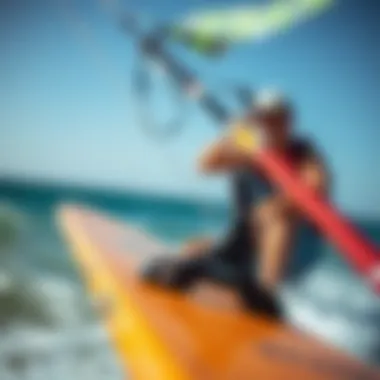
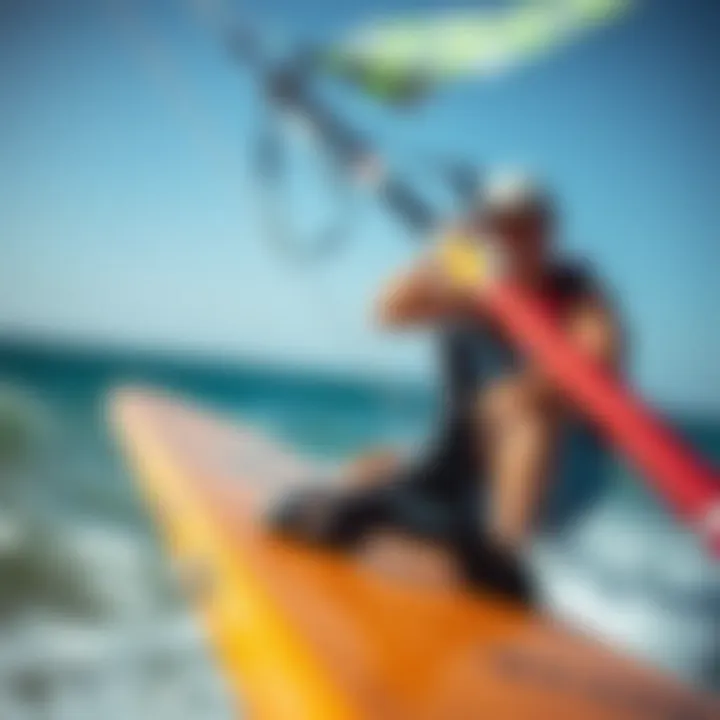
"Regular care of your gear is a small price to pay for avoiding costly repairs or replacements in the future."
By maintaining these basic cleaning and storage routines, kiteboarders can ensure that their handles remain in optimal condition, ready to perform when they hit the water again.
Safety Considerations
When it comes to kiteboarding, safety is not just a buzzword—it's an essential framework for enjoying the sport without a hitch. The nuances associated with kiteboard handles cannot be overlooked. They are the link between you and the kite, directly influencing both control during maneuvers and the overall safety on the water. This section delves into the crucial elements concerning safety, focusing on two primary areas: evaluating wear and tear, and ensuring secure attachment to the board.
Evaluating Wear and Tear
Handles, like any gear, face the inevitable consequences of use. It's paramount to routinely check them for signs of wear and tear. Small cracks, frayed material, or an unusual slackness can signal trouble brewing under the surface.
- Regular Inspections: Make it a habit to inspect your handles before and after each session. Look closely for things like:
- Functionality Testing: A simple squeeze test can reveal whether the handle’s grip is still intact. Does it feel slippery or loose? If yes, it might be time to replace it. Keeping an eye on these aspects not only enhances your safety but can significantly reduce the risk of an unexpected mishap while on the water.
- Cracks in the structure
- Signs of discoloration from UV exposure
- Abrasion marks, particularly at connection points
"An ounce of prevention is worth a pound of cure." This old adage rings particularly true in kiteboarding.
Optimizing Secure Attachment to the Board
Beyond the handle itself, how it attaches to the board is equally crucial. An insecure connection can lead to disaster, especially while performing jumps or tight turns.
- Attachment Checkpoints: Ensure that the handle is well-attached to the board by checking:
- Testing the System: Pull on the handle firmly before each ride. It should feel solid and well-integrated with the board. If there’s any wobble, reconsider whether you should ride it.
- Upgrade Options: Some newer models come with innovative attachment designs that enhance stability. If your current handle setup seems outdated, consider investing in a more secure system that provides additional safety guarantees.
- Bolts or Screws: Are they tightened? Loose screws can spell trouble, so grab a wrench or screwdriver before heading out.
- Mounting Points: Look for any signs of stress at the attachment points. Lookout for any cracking or deformation.
Technological Advancements in Handle Design
In the rapidly evolving world of kiteboarding, technological advancements in handle design stand at the forefront, revolutionizing how riders interact with their boards. These enhancements not only increase performance but also elevate safety and user experience. As kiteboarding gains popularity and complexity, the development of innovative handle designs is becoming increasingly significant for both recreational and professional riders.
Smart Handles and Sensors
Modern kiteboard handles are making a leap into the digital age. The integration of smart technologies introduces a whole new level of functionality. These smart handles come equipped with sensors that can track a variety of metrics. For example:
- Grip pressure: Understanding how firmly you hold the handle can be crucial for maneuvering.
- Angle of pull: This data helps in determining how a rider interacts with the kite, offering insights into aerial dynamics.
- Performance analytics: Many smart handles connect to apps on smartphones, allowing for detailed analysis post-ride.
This tech isn’t just a gimmick; it has practical implications. Riders can adjust their techniques based on real-time feedback, leading to improved skills over time. Moreover, it can enhance safety; for instance, knowing the metrics of a hard pull can help anticipate potential falls or wipeouts.
"With the rise of smart technology, kiteboarding is not just a sport anymore; it’s becoming a science!"
Customization Features
Another noteworthy advancement in handle design lies in customization. Today’s riders have diverse preferences and styles, so why should their gear be any different? Customizability allows kiteboarders to tailor handles to meet their specific needs. Here’s how:
- Adjustable grips: Some handles offer features like adjustable grip widths or textures. This allows riders to pick a grip that feels comfortable, regardless of hand size.
- Color options: Personalizing the aesthetics can make a handle feel uniquely yours, creating a more enjoyable riding experience.
- Weight adaptability: Some manufacturers are now producing handles that allow users to add or remove weight, affecting balance and performance according to personal preference.
By allowing riders to customize their gear, manufacturers empower them to optimize their performance. A well-fitted handle can improve handling and responsiveness, contributing to a more enjoyable riding experience.
Impact of Handle Choice on Performance Metrics
Handle choice is paramount in the realm of kiteboarding, profoundly influencing performance metrics that affect both novice and seasoned riders. When kiteboarders select a handle, they inadvertently select a set of characteristics that intertwine with their performance on the water. This choice extends beyond mere aesthetics or brand loyalty—it encapsulates crucial elements such as control, stability, and maneuverability.
Influence on Control and Stability
A kiteboarder's ability to manage the board and kite effectively is crucial for success. The handle acts as a critical interface between the rider and the kite, essentially serving as the steering wheel that dictates both control and stability.
- Grip Comfort: A handle with adequate grip enhances the rider's ability to maintain control, particularly in choppy waters or intense conditions. A poorly designed grip can lead to slipping, which could result in loss of control, making that ride an uphill battle.
- Weight Distribution: Lighter handles can often improve control. The distribution of weight across the handle impacts how a kiteboard reacts during maneuvers. Heavier handles may lead to sluggishness, hampering quick adjustments.
- Response Time: A handle that offers instant feedback allows a rider to react promptly to changing conditions. Such responsiveness is essential, especially when navigating tricky wind patterns or executing complex tricks.
Ultimately, choosing the right handle can make the difference between a controllable ride and a harrowing struggle against the elements.
Effect on Maneuverability
Maneuverability refers to how deftly a kiteboard can change direction or execute tricks, and it, too, is heavily influenced by the chosen handle.
- Shape and Size: The dimensions of a handle significantly influence its maneuverability. A compact handle allows for quicker turns and more aggressive movements; larger handles may provide leverage but often sacrifice agility.
- Attachment Mechanism: The way a handle attaches to the kiteboard also plays a role. Quick-release systems can enhance maneuverability by enabling quick transitions. If a rider is comfortable with the handle mechanics, they can execute sharp turns or fast jumps without hesitation.
- Style of Riding: Different riding styles demand different handle characteristics. Freestyle kiteboarders may prefer a smaller, lighter handle for easier spins and flips, whereas freeriders might lean toward more robust options that lend stability for high-speed runs.
In short, the selection of a handle can either liberate a rider’s movements across water or tether them to limitations, exemplifying the significance of thoughtful choice in handle design. The metrics of performance in kiteboarding hinge not only on skill but significantly on this seemingly simple piece of equipment.
Comparative Analysis of Popular Handle Brands
Understanding the landscape of kiteboard handles requires an examination of the various brands that dominate the market. This section shines a light on the pros and cons associated with three notable brands: Slingshot, Naish, and Cabrinha. By gauging each brand's offerings, kiteboarders can make informed decisions that go beyond mere aesthetics and delve into performance, durability, and overall user experience.
Knowing the differences between these brands can significantly impact your performance on the water. Factors such as grip design, materials used, and safety features all vary widely across manufacturers. When kiteboarding, having a handle that fits one's style and skill level can drastically enhance the ride quality and safety. Therefore, comparing these brands is essential for anyone looking to elevate their kiteboarding experience.
Brand A Overview
Slingshot is a household name in the kiteboarding community, particularly known for its innovative designs and commitment to quality. The Slingshot surf handle often features a soft grip and is ergonomically designed for both comfort and control. This brand is celebrated for its robust construction, which stands the test of time, even in demanding conditions. Riders who enjoy aggressive maneuvers will find that the handle allows for quick transitions and stable grip, lending confidence during tricks.
One of the standout features of Slingshot's handle is the inclusion of a safety release system, which enhances peace of mind, especially for beginners. Their paddling handle is also notable for its lightweight nature, crafted for maximizing performance without the extra weight.
Brand B Overview
Naish kiteboarding brings its own flavor to the handle game through a blend of functionality and design aesthetics. The Naish kite handles usually come with a more natural shape, imitating the natural grip of your hand, which offers excellent control for a more intuitive riding experience. This is particularly beneficial for users who might be adapting to different techniques or riding styles.
The material combinations used in Naish handles focus on enhancing durability while keeping the weight manageable. Their handles often include adjustments that allow for more customizability, catering to a variety of rider preferences. Moreover, this brand's handles generally come equipped with colorful designs, appealing to riders who value style as much as functionality. The polymer grips they use help reduce slips, ensuring a solid hold during the most exhilarating moments.
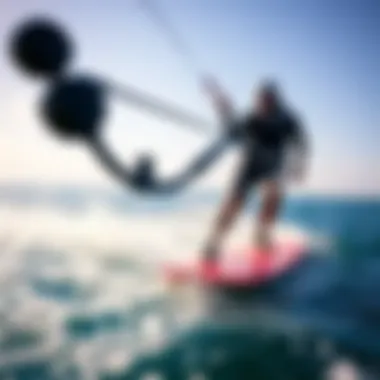
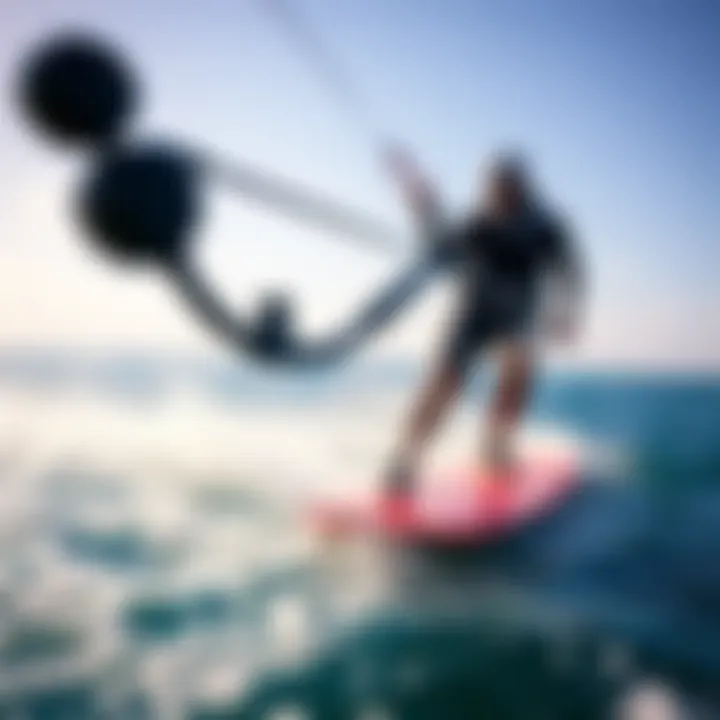
Brand Overview
Cabrinha is another big player worthy of attention. They are known for producing high-performance handles that cater to a competitive edge. Cabrinha handles often include unique innovations like additional padding designed to provide extra comfort on long rides or during heavy use.
The Cabrinha kite handles pride themselves on their responsiveness. Many riders find that this brand’s products deliver a delicate balance between lightweight construction and sturdy performance, which is important for technical riding. They also focus on user safety with features designed to minimize chances of accidental releases; they've taken into account that the handle's design plays a crucial role in ensuring a rider stays connected to their kite effectively.
To summarize this comparative analysis:
- Slingshot: Known for robust construction and safety features.
- Naish: Focuses on ergonomic designs and usability adjustments.
- Cabrinha: Driven towards performance and responsiveness.
Finding the right handle from these brands can significantly enhance your kiteboarding experience, so take the time to explore each option carefully.
"The right tool can make all the difference in achieving your goals."
For a deeper look into kiteboarding trends, visit: Wikipedia on Kiteboarding and Kiteboarding Forum.
This comparative analysis reveals how brand selection is not merely about personal preference but rather about matching a handle’s qualities with a rider's requirements for optimal performance and enjoyment.
Regional Preferences in Handle Selection
Understanding regional preferences in kiteboard handle selection shines a light on how local culture, riding conditions, and user experience shape the choices made by kiteboarders. This section dives deep into how geographical differences influence handle design, material selection, and functionality, ultimately improving overall performance. Not merely a matter of style, these regional preferences often reflect the unique challenges posed by varied environments, from the windswept beaches of the Atlantic to the fresh water of the Great Lakes.
Local kiteboarding communities have developed distinct preferences based on the conditions they frequently encounter. This affects not only the physical attributes of the handles chosen but also the mindset and skills of the riders.
North America Trends
In North America, kiteboarders often favor handles that offer versatility and durability. Riders along the coastlines, where winds can shift unexpectedly, prioritize equipment that can adapt to changing conditions. Many enthusiasts gravitate toward adjustable handles, allowing for customization based on personal comfort and changing riding styles. Furthermore, the rampant popularity of kiteboarding schools in places like Florida and California has added to the demand for handles designed to accommodate beginners. Here, ease of use is paramount. Common trends noted among North American kiteboarders include:
- Wider grips: Providing more control, particularly in turbulent conditions.
- Sturdier materials: Handles constructed from composite materials are common, balancing strength with weight.
- Colorful designs: The aesthetic appeal is as much a consideration as functionality; brighter handles seem to be preferred due to visibility.
Additionally, the influence of social media cannot be overlooked. Riders often share their preferences and experiences online, leading to rapid shifts in what is considered a 'must-have' in terms of equipment. The engagement from both industry professionals and amateurs fosters an ecosystem where innovations can spread like wildfire, often leading to localized trends.
European Preferences
In Europe, the approach to handle selection presents a different narrative. European kiteboarders tend to prioritize lightweight designs that remain robust without sacrificing agility. The riding conditions vary dramatically from location to location – consider the flat waters of the lagoons in Tarifa versus the choppy seas of the North Sea. Some prevalent preferences amongst riders in Europe include:
- Streamlined shapes: These handles are designed for enhanced performance during tricks and jumps, favored by freestyle riders.
- Integrated safety features: Ensuring a secure grip is vital, especially in more extreme conditions common to European waters.
- Ecologically-friendly materials: A rising trend towards sustainability means that many manufacturers are now experimenting with recyclable materials that do not compromise quality.
European riders also tend to rely on community feedback more heavily than their North American counterparts. Local kiteboarding clubs regularly hold discussions about equipment preferences, which makes for a highly informed consumer base that values both performance and sustainability.
“A handle is not just a piece of gear; it connects you to the water, the wind, and the very essence of kiteboarding.”
In summary, understanding these regional preferences helps kiteboarders choose handles that align with local riding conditions and community values. As diverse as the sport itself, handle selection is influenced both by pragmatic needs and deeper cultural currents that define kiteboarding practices worldwide. The ongoing evolution of kiteboarding gear ensures that preferences will continue to adapt alongside the sport itself.
Future Perspectives on Kiteboard Handle Development
As the sport of kiteboarding continues to evolve, the development of kiteboard handles becomes increasingly important. Innovations in design and technology not only enhance performance but also reflect a growing commitment to sustainability and user experience. This section dives into the future of kiteboard handles, focusing on sustainability innovations and enhancements in user experience that can significantly impact the way kiteboarders engage with their gear.
Sustainability Innovations
The push for sustainability in outdoor sports has gained momentum, and kiteboarding is no exception. Manufacturers are recognizing the importance of creating eco-friendly products that do not compromise on performance. Here are some key trends:
- Recycled Materials: More companies are experimenting with recycled plastics and composites. This not only reduces waste but also often produces surprisingly durable handles that hold up well under the strain of kiteboarding.
- Biodegradable Options: Some cutting-edge brands are exploring biodegradable materials that break down naturally at the end of their lifecycle. This represents a bold step towards reducing the landfill footprint of sports gear.
- Minimalist Design: Innovations in design are leading to products that maintain structural integrity while using less material. This approach not only lessens environmental impact but also results in lighter handles that can improve performance on the water.
The focus on sustainability resonates with many riders, who are increasingly seeking products that align with their values. As these innovations take hold, kiteboard handles are not just gear; they become part of a larger commitment to protecting the natural environments where people love to ride.
Enhancements in User Experience
User experience in kiteboarding is critical. The handle serves as a direct point of contact between the rider and their gear, so any improvements here can make a substantial difference in overall performance and enjoyment. Here are some forward-looking enhancements that pilots may soon experience:
- Smart Technology Integration: Imagine a handle equipped with built-in sensors that measure grip pressure and provide feedback on technique. Such technology can lead to tailored riding styles, allowing users to hone their skills more effectively.
- Ergonomic Customization: Advances in ergonomic design allow for handles that adjust to fit individual hand sizes and riding styles. These customizations can lead to greater comfort and less fatigue during long sessions.
- Enhanced Grip Materials: Future handles may utilize advanced materials that provide superior grip even in wet conditions. This would improve control and confidence when tackling challenging tricks or navigating rough water.
"The evolution of handles encompasses more than just style; it's about creating a seamless synergy between the rider and their board, enhancing performance from the ground up."
The End and Final Thoughts
The exploration of kiteboard handles can seem like a small slice of the broader kiteboarding experience, but neglecting this aspect can hinder a rider's performance and overall enjoyment. As we've delved into various sections of this article, it's clear that the handle isn't just a mere appendage; it plays a pivotal role in control, safety, and the execution of maneuvers.
In summation, the significance of understanding kiteboard handles is multi-faceted:
- Performance Enhancement: The right handle can drastically improve the ability to control the kite, thus affecting speed and turn efficiency. A solid grip leads to better connection with the board, ensuring that a rider can execute tricks without the fear of losing control.
- Personal Preference: Each rider has unique needs based on their style, skill level, and the types of conditions they frequently encounter. Recognizing one’s preferred handle type can lead to a tailored kiteboarding experience.
Moreover, the discussion around materials, safety considerations, and potential technological advancements underscores the need for informed choices in handle selection.
"In the world of kiteboarding, a handle might seem trivial, but it often becomes the lifeline of a rider's balance and maneuverability."
In this light, the comprehensive analysis provided in this article serves as a valuable resource for kiteboarders ranging from beginners to seasoned experts. A well-made handle, chosen with careful consideration, ultimately translates to a more fulfilling ride, blending safety with performance.
Summarizing Key Insights
As we wrap up, consider these pivotal points regarding kiteboard handles:
- Material Matters: The longevity and functionality of kiteboard handles typically stem from the materials used in the manufacturing process. Plastic, composites, and metal components each have their own advantages and can significantly impact performance.
- Ergonomics Take Center Stage: With innovations focusing on ergonomics, riding becomes easier and this helps minimize potential strain on the hands during extended sessions. A well-designed ergonomic handle ensures a relaxed grip, leading to improved performance.
- Advancements on the Horizon: The introduction of smart technologies into handle designs could pave the way for an enhanced riding experience, with integrated sensors able to provide real-time feedback. This is especially beneficial in informing riders of their grip efficiency.
Encouraging Informed Choices
Ultimately, becoming a discerning kiteboarder involves a thoughtful approach to equipment selection, especially when it comes to handles. The points discussed throughout this article are essential to making decisions that cater to individual needs and riding styles. Here are some crucial considerations:
- Evaluate Comfort and Fit: It’s vital to find a handle that feels good in your hands. Consider spending time testing different types at your local shop or during a kiteboarding event.
- Maintenance Implications: A handle that requires minimal care can provide a hassle-free experience. Look for options designed for durability and ease of cleaning, especially when considering exposure to saltwater and sand.
- Stay Updated on the Latest Trends: The kiteboarding market continually evolves, meaning it’s important to keep an eye on advancements in handle design and functionalities. Joining forums or communities like reddit.com/r/Kiteboarding can be beneficial for staying in the loop.
With the right knowledge at their fingertips, kiteboarders can elevate their game, making informed choices that enhance both performance and safety.















